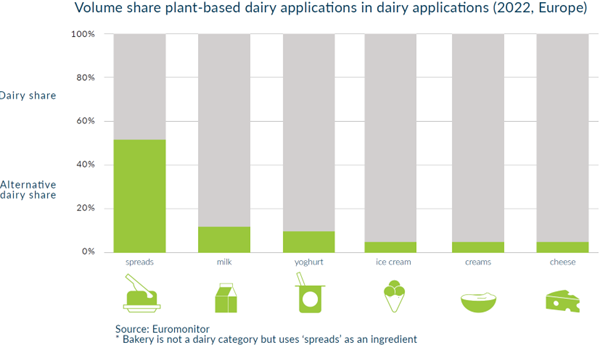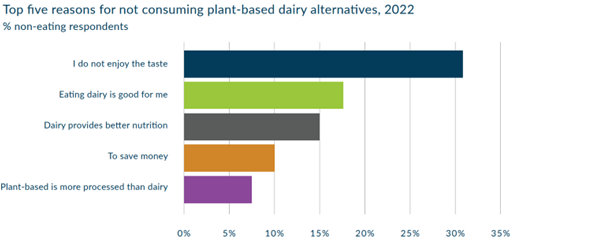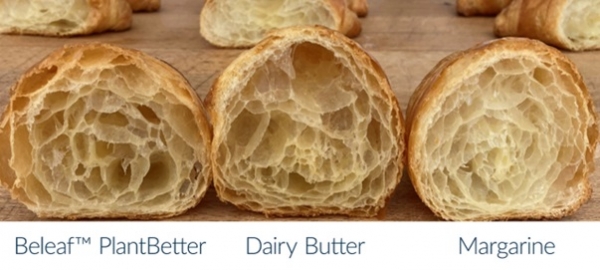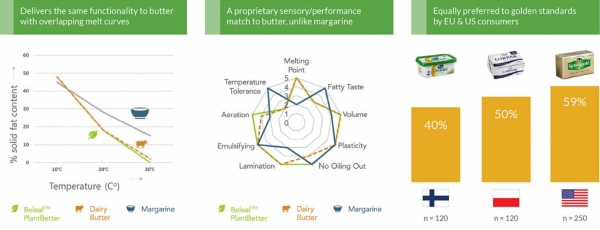Promotional Features
Savouring the future of plant-based butter
In an era of evolving consumer preferences, the future of butter has arrived in the form of plant-based alternatives.
While supermarkets have long embraced plant-based products, consumers continue to seek dairy and meat replacements that offer exquisite taste, texture, and nutritional benefits. The current food landscape also extends beyond personal wellness and health. Today, sustainability ranks high on the list of consumer priorities, driving demand for products that reduce carbon emissions and enhance animal welfare.
The plant-based revolution
The plant-based category, especially dairy alternatives, is experiencing exponential growth. In 2022, it boasted a market value of approximately $21 billion, with projections soaring to $36 billion by 2027.1 As shown in the graph below, plant-based spreads command a substantial 56% share, while alternative dairy milk accounts for 13%.
However, the majority of other dairy categories lag behind, with only a 1-3% share of other plant-based alternatives. This reveals significant growth potential, particularly in the quest for milk and butter alternatives, which present ample room for expansion in the market.
Among dairy alternatives, products targeting dairy butter replacements are surging ahead, encouraging a growth in multiple dairy plant-based applications. Yet, replicating the complex nature of dairy butter or milkfat – with its wide range of applications from spreads to baking and ice cream – poses a considerable challenge.
Figure 1: Volume share plant-based dairy applications in dairy applications (2022, Europe)
Although more consumers are looking for dairy-free alternatives, they still want eating experiences that are as close as possible to traditional dairy products. For instance, recent research by Euromonitor indicates that taste is one of the top five reasons why consumers are turned off when it comes to plant-based products.
Figure 2: Top five reasons for not consumer plant-based dairy alternatives, 20221
Furthermore, flexitarians, who aren't completely cutting out meat or dairy, are actually propelling the demand for plant-based options. Given that they still enjoy animal-based products, their expectations towards plant-based are very high: delicious taste, exciting variety and appealing positioning are key.
A game-changer from Bunge
To meet the demand for plant-based alternatives, Bunge introduces Beleaf™ – a range of plant-based lipids for meat and dairy alternatives. This range helps deliver the same sensory experience including appearance, texture, melting behaviour, and taste as traditional meat and dairy.
Zooming in on the realm of bakery, there is a rising trend in baked savoury snacks, especially in the wake of the COVID-19 pandemic. And, unsurprisingly, vegan is no longer an ‘add-on’ to a bakery’s range but an integral part of it. It is becoming crucial for bakers to offer dairy-free and vegan options as part of their mainstream offerings, rather than catering only to a niche market.
Bakeries, especially artisanal and smaller establishments, are grappling with mounting pressure to meet the ever-increasing demands of consumers while simultaneously managing operational costs. Beyond the critical elements of taste, texture, and sustainability, rising production costs in the food industry present formidable challenges. And within this context, butter is an essential ingredient that contributes to exceptional bakery products, including cherished delights like croissants.
Introducing Beleaf™ PlantBetter
Creating a plant-based butter that replicates dairy butter's sensory qualities begins with a deep understanding of consumer preferences and industry demands. Across various product categories, consumers consistently seek improved texture, taste, health benefits, affordability, and reduced environmental impact. Customers are thus seeking solutions that not only deliver the sensory performance of dairy butter but are also priced competitively to ensure accessibility and cost-effectiveness.
With these priorities in mind, Bunge has focused on developing a product that could meet customers’ expectations while matching the industry’s gold standard – dairy fat.
The result? Beleaf™ PlantBetter, a modular fat system capable of replacing dairy fat while preserving the quintessential attributes of dairy butter. This dedicated plant-based solution to replace dairy fat (milkfat or butter) is meticulously designed to align with the latest industry trends, with a particular focus on taste and sustainability.
Notably, this system not only achieves cost reduction compared to dairy fat but also mitigates price volatility. In addition, Beleaf™ PlantBetter reduces greenhouse gas (GHG) emissions by 50% and has an extended product shelf life compared to real butter.
It opens the door to seamless dairy fat substitution across a wide array of applications, spanning from spreads and baking to ice cream, cheese, creams, and other confectionery items.
Figure 3: Croissant made with Bunge’s Beleaf™ PlantBetter, Dairy butter and Margarine
The close resemblance between croissants made with dairy butter and Beleaf™ PlantBetter is evident in the visual comparison of croissants made with different ingredients, highlighting the differences in volume, shape, and layered structure.
Figure A Figure B Figure C
Figure 4: Physical and sensorial properties of Bunge’s dairy-replacing fat system
Furthermore, as shown in Figure 4A, Bunge have crafted a fat system so finely tuned that it mirrors the melting characteristics of dairy fat to such an extent that it becomes virtually indistinguishable. This precise match has a profound impact on both the sensory experience and the product's performance across various applications.
For instance, the mouthfeel and melting behaviour during consumption closely resemble those of dairy butter, as illustrated in Figure 4B. Moreover, critical performance criteria, such as volume (pertaining to baking applications), are on par with dairy fat. It is also important to emphasise that taste is a pivotal factor in this equation. The modular fat system allows Bunge to craft diverse products that are equivalent to the highest-quality dairy fat found in various regions. The secret to Beleaf™ PlantBetter’s qualities lies in the carefully selected ingredients.
Extensive consumer taste tests conducted in different regions have consistently yielded exceptional liking scores, surpassing industry standards, as demonstrated in Figure 4C.
Emissions reduction with Beleaf™ PlantBetter
Research conducted by Taste Tomorrow Research in 2020 highlights sustainability as a top priority among consumers. According to this research, more than half (53%) of UK consumers actively seek out food products that are produced with a focus on the environment.
Bunge keeps sustainability at the forefront with every decision. Beleaf™ PlantBetter offers a remarkable 50% reduction in GHG emissions when compared to traditional dairy butter, as illustrated in Figure 3. Specifically, Bunge Beleaf™ PlantBetter boasts a Product Carbon Footprint (PCF) of approximately 5.9 kg of CO2 emissions (see Figure 5 below).
Figure 5: Product carbon footprint of Bunge’s Beleaf PlantBetter versus dairy butter
A commitment to excellence in every bite
The Bunge plant-based dairy fat replacement technology has been designed with flexibility in mind, offering food manufacturers the chance to craft exceptional, tailored products. This inaugural product is a resounding testament to Bunge’s commitment to environmental priorities, cost-efficiency, and unwavering high performance.
The journey doesn't end here; Bunge plans to introduce additional plant-based innovations spanning diverse applications, from ice cream to confectionery. The future of food production pivots resolutely on sustainability and cost-effectiveness, all while keeping customers’ taste buds delighted at every turn.
References
1. Euromonitor/Bunge data.
Bibliography
Euromonitor. (2023). Plant-Based Foods Face Key Challenges.
Barry Callebaut. Plant-Based Consumer Trends.
Euromonitor. Passport Permissible indulgence: Finding the Balance.
Taste Tomorrow Research, Terra Institute, Liao & AI study 2020.
British Baker. Top Bakery Trends 2023 report.








